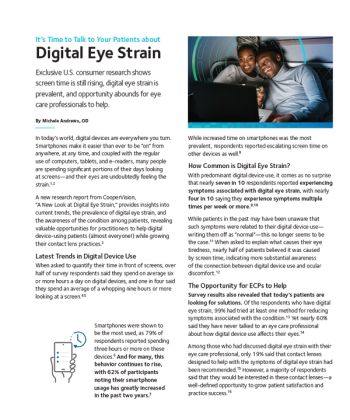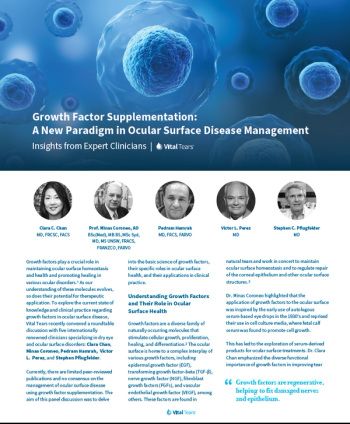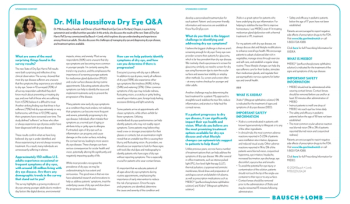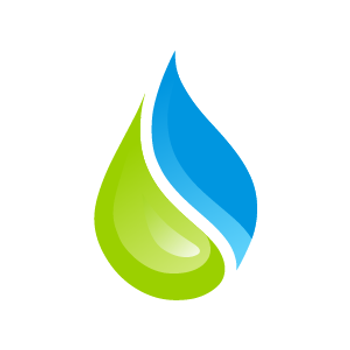
Don’t Miss the Signs of Thyroid Eye Disease (TED)
Optometrists are well-positioned to detect the early warning signs of debilitating eye conditions, helping patients avoid long-term damage and changing the trajectory of their care. One such condition is Thyroid Eye Disease (TED) – a chronic autoimmune condition that can worsen over time and lead to potential vision loss in severe cases.1,2
I would bet that when most optometrists think about TED, proptosis comes to mind. Though proptosis is an obvious symptom of the condition, it is not the only one we should be looking out for. In fact, other symptoms can be so subtle, they are unfortunately easy to miss.
One such symptom is dry eyes. In one study, seventy-two percent of TED patients say dry eyes are their most frequent source of eye discomfort; however, this symptom is often misdiagnosed as allergies or conjunctivitis.3,4 Other common symptoms of TED include diplopia, pain or pressure behind the eyes, eyelid retraction, photophobia and redness, swelling, and excessive tearing.1
To help determine if my patients have TED, I typically start with a few questions and exams:
- Medical history: Ask if they have been diagnosed with a thyroid condition. Up to 50% of people living with Graves’ disease may develop TED.5
- Eyelid retraction: Examine the tone of the eyelids, as well as the blink anatomy.2
- Eye symmetry: Look for a variance in symmetry between the right and the left eye. If you do see an asymmetry, ask about it and if it is longstanding or something of more recent onset. With most patients having cell phones with them in the exam room, oftentimes it is easy to see previous pictures of them to compare against their current appearance.
- Slit lamp: Perform a slit lamp exam; the image below shows a patient who presented with a chief complaint of dry eyes. The symptoms were present because of ocular surface exposure which may be secondary to TED.
TED is commonly a manifestation of a systemic condition called Graves’ disease. Although it is critical to identify and diagnose patients with TED at the early signs or symptoms, it is also critical to understand appropriate care to help these patients. Oftentimes this involves oculoplastic or TED specialist referral for further analysis, which may include MRIs, CT scans or orbital imaging to help determine next steps. If it is TED, there are treatment options available that may help.
TED patients often go several years without a proper diagnosis, leading to significant delays in treatment and ultimately affecting their physical and psychological wellbeing. TED can have a profound impact on some patients’ lives, negatively impacting the ability to do daily tasks that we take for granted such as driving or reading.
As optometrists, we can play an important role in the early identification of TED, ultimately helping to get our patients the care they deserve.
For more information about the signs and symptoms of TED, visit
References
Bothun ED, Scheurer RA, Harrison AR, Lee MS. Update on thyroid eye disease and management. Clin Ophthalmol. 2009;3:543-551.
Barrio-Barrio J, Sabater A, Bonet-Farriol E, Velazauez-Villoria A, Galofre J. Graves’ Ophthalmopathy: VISA versus EUGOGO Classification, Assessment, and Management. J Ophthalmol. 2015.
Bartley GB. The epidemiologic characteristics and clinical course of ophthalmopathy associated with autoimmune thyroid disease in Olmsted County, Minnesota. Trans Am Ophthalmol Soc. 1994;92:477-588.
Estcourt S, Hickey J, Perros P, Dayan C, Vaidya B. The patient experience of services for thyroid eye disease in the United Kingdom: results of a nationwide survey. Eur J Endocrinol. 2009;161(3):483-487.
Bahn RS. Graves’ Ophthalmopathy. N Engl J Med. 2010;362(8):726-738
© 2022 Horizon Therapeutics plc DA-UNBR-US-01051 10/22
Newsletter
Want more insights like this? Subscribe to Optometry Times and get clinical pearls and practice tips delivered straight to your inbox.












































